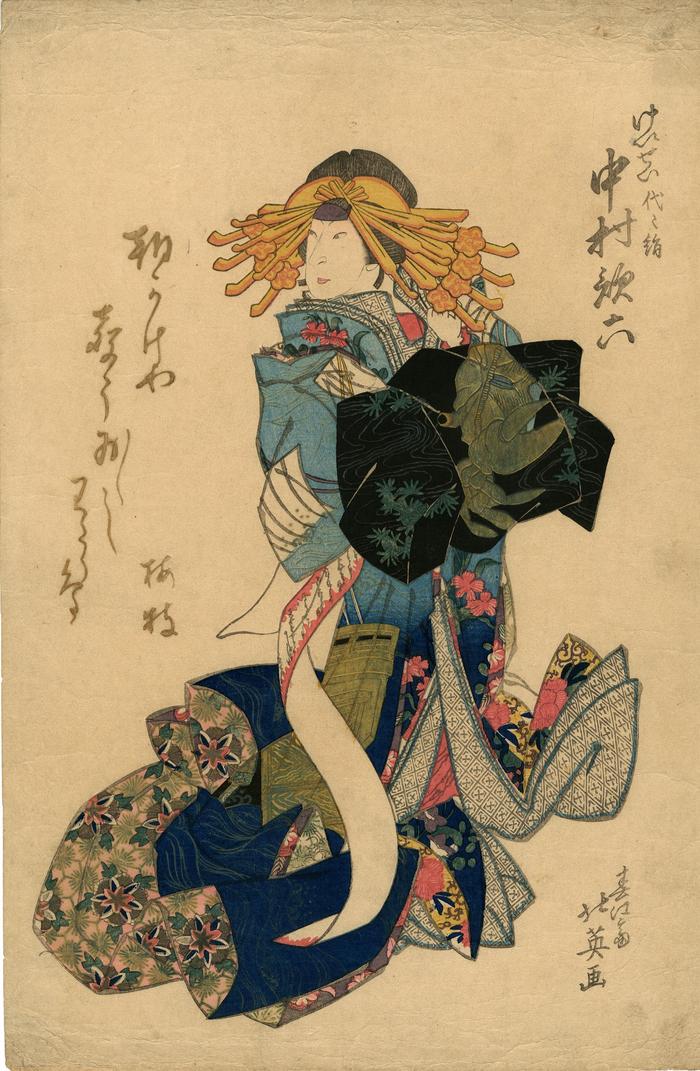Shunbaisai Hokuei (春梅斎北英) (artist )
Nakamura Karoku I (中村歌六) as the courtesan Yoyoginu (けいせい代々絹) from the play Yaemusubi Jiraiya monogatari (柵自来也談) (The Story of Jiraiya at the Weir)
08/1832
10.5 in x 15.5 in (Overall dimensions) Japanese woodblock print
Signed: Shunkōsai Hokuei
春江斎北英
Waseda University
National Museums of Scotland
Waseda University - another 1832 Hokuei of a courtesan with a lobster, but on her kimono this time
Nationaal Museum van Wereldculturen (Rijksmuseum Volkenkunde, Leiden) via Ritsumeikan University One of the rarest of Hokuei's designs. There was more than one printing of this print and this one is probably from the deluxe edition because of the use of metallic inks.
This performance took place at the Kado-za in 8/1832. The kani or crab decorating the front of the obi in this printed with metallic inks. The example from the National Museums of Scotland is done the same way. However, the example at Waseda University used a deep red for the crab's shell.
****
Yaemusubi Jiraiya monogatari [柵自来也談] is said to be the earliest dramatization of a novel into the kabuki theater. This was done in 1807 by "...Chikamatsu Tokuzō [近松徳三 - 1751-1810] and others after a story about the magician-thief Jiraiya by the Edo writer Kanwatei Onatake."
Source: The Theatrical World of Osaka Prints by Roger Keyes, p. 142.
****
At Osaka Prints they wrote:
"The novel Katakiuchi kidan Jiraiya monogatari 報仇奇談自来也説話 (1806-07) by Kanwatei Onitake 感和亭鬼武 (1760-1818), a disciple of the celebrated writer Santô Kyôden (山東京伝 1761-1816), was the first yomihon or literary reading book ("book for reading": 読本 or 讀本) to be adapted for the kabuki stage. It was also the prototype for gôkan ("combined volumes": 合巻), popular illustrated novels issued in multi-volume sets.
The yomihon focused on two revenge incidents presented with an overlay of didacticism or morality lessons. Yaemusubi Jiraiya monogatari (The story of Jiraiya at the weir: 柵自来也談) premiered in 9/1807 at the Kado no Shibai, Osaka. It is one of several Jiraiya mono (Jiraiya plays) recounting the exploits of the righteous bandit Jiraiya (自来也) and his band of outlaws who, Robin Hood-like, robbed the wealthy and gave back to the poor. In one episode, Jiraiya rescues Tomokichi, a baby whose father, mother, and grandfather were murdered by the villain of the tale. Much later, Jiraiya aids Tomokichi in taking his revenge when the young man beheads his nemesis.
Design
The courtesan Yoyoginu is adorned in one of the over-the-top costumes that were such big hits with fans of the onnagata (lit., "womens' manner": 女方 or 女形), male actors specializing in female roles in kabuki. The extraordinary obi (sash: 帯) is patterned with a giant crab printed in gold-colored brass. The gradated blue outer robe features sailing ships. Her many oversized kanzashi (hairpins: 簪 or 笄) are arrayed in a cantilevered display of outrageous opulence. Only the highest ranking keisei (lit., "castle topplers": 傾城 also 契情 or けいせい) could affored such such garments and adornments. The poem on the left is signed "Baishi" (梅枝), the haigô (literary name: 俳号) of the actor Nakamura Karoku I."
****
Also illustrated in color in Kabuki Theatre Prints by Rosina Buckland, National Museums of Scotland, 2013, p. 27. Ms. Buckland wrote: "This design presents the play's love-interest, Yoyoginu, depicted wearing an outer robe decorated with boats and an ostentatious sash (tied at the front to indicate a courtesan) on which there is a splendid crab, printed in metallic pigment. Such extravagance in the use of pigments was not found in commercial actor prints produced in Edo. The print is inscribed with a poem by Ume-eda, which translates, 'In the morning shadows, the freshness in the voice of the migratory bird.' "
actor prints (yakusha-e - 役者絵) (genre)
Kyōto-Osaka prints (kamigata-e - 上方絵) (genre)
Nakamura Karoku I (初代中村歌六) (actor)
Jiraiya (自来也) (role)
